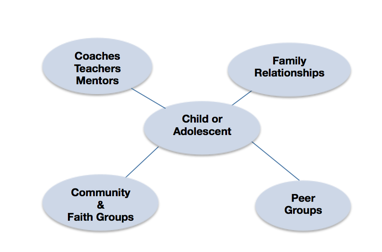Children & Adolescents with Mental Health Disorders: How Adults Can Help
At any given time, one out of five children and adolescents in the U.S. experiences a mental health disorder. A mental health disorder affects a person’s feelings, thoughts and behaviors. This can cause various problems in daily life. It is important to know that mental health is a part of physical health. The brain is an organ much like the heart or the stomach. Just like physical health, some mental health disorders can be short-term, some can come and go and some are ongoing. Children and adolescents with mental health disorders need adults who are encouraging and understanding.
Signs of a Mental Health Disorder
- Cries often, sleeps a lot or unmotivated for two or more weeks
- Is more fearful or clingy than usual or startles easily
- Has sudden fear or anxiety
- Cannot focus, finish tasks or stay still
- Feels very sad for more than two weeks
- Has repeating and upsetting thoughts about an experienced trauma
- Experiences worry or fears that limit age-appropriate behaviors
- Has severe mood swings
- Lacks interest in activities usually enjoyed
- Shows big changes in personality or behavior
- Throws up, uses laxatives or stops eating to lose weight
- Has trouble in relationships
- Exhibits out-of-control and risk-taking behavior
- Increases use of drugs or alcohol
- Causes harm to self or mentioning/planning suicide
The Role of Adults
Adults can be helpful to a child or adolescent with a mental health disorder. Learning about how to be helpful and choosing to speak and act in helpful ways can make a very big difference to a child or adolescent in need of help.
What to Do:
- Learn about the disorder
- Learn about warning signs
- Learn about treatments
- Teach the child about his/her disorder
- Learn recovery skills
- Respect the child’s rights and need for privacy
- Know about mental health stigma
- Be loving and accepting
- Listen to the child or adolescent
- Comfort the child or adolescent when needed
- Be patient, kind and gentle
- Join a support group
- Help the child get mental health services
- Encourage the child to join a support group
- Encourage the child to participate in activities
- Offer a ride or company
What to Say:
- “How can I help you?”
- “I am proud of you.”
- “I support you.”
- “I will help you.”
- “I believe in you.”
- “I am glad you are better.”

What NOT to do:
• Ignore the child when he/she shares
• Assume the child’s motive for actions
• Yell at the child or adolescent
• Ignore warning signs
• Threaten with punishment
• Pressure the child or adolescent
• Make fun of the child or adolescent
• Invade the child or adolescent’s privacy
• Act impatient or frustrated
• Criticize the child or adolescent
• Complain about the child’s disorder
What NOT to say:
• “Get over it.”
• “What’s wrong with you?”
• “I know how you feel.”
• “I am disappointed in you.”
• “That was stupid.”
• “This is your fault.”
When to Get Help
Mental health disorders, like anxiety and depression, are different than stress or sadness. For children and adolescents, mental health disorders often create problems at home, in school and with peers. Problems can range from fights with peers or avoiding others to more serious situations like suicide. Treatment for mental health disorders, like physical health, may include both medicine and changing thought patterns and behaviors. A doctor, therapist or psychiatrist, can help with understanding more about mental health and specific mental health disorders.
How to Get Help
Talk with your pediatrician or family doctor
- Make a list of signs/symptoms to discuss at the appointment
- Request a referral for an evaluation and mental health services
- Take any reports from school or day care staff
Contact a local licensed therapist or psychiatric hospital
- https://therapists.psychologytoday.com/rms/state/Oklahoma.html
- http://www.ushospital.info/Psychiatric/Oklahoma.htm
- https://www.healthguideusa.org/psychiatric/oklahoma_psychiatric_hospitals.htm
Contact your local support group and connect with other families
http://www.namioklahoma.org
1-800-950-NAMI (6264)
Work with the school
- Ask for an appointment with the school counselor or ask for a recommendation to a licensed therapist
- Oklahoma Cooperative Extension Fact Sheets
The Difference between a Therapist and Psychiatrist
A therapist is licensed by the state to provide mental health services. They can be a social worker, counselor or psychologist. Therapists usually see their clients once per week. They listen to specific mental health needs and teach skills to build mental health. Psychiatrists are medical doctors that treat mental health disorders with medication. Psychiatrists are usually seen at least monthly. Research shows the combination of both medicine and therapy is most helpful for most mental health disorders.
More Mental Health Resources
Mental Health America
http://www.nmha.org/mental-health-information
National Suicide Prevention Hotline
1-800-273-TALK (8255)
National Treatment Referral Line
18777264727
Crisis Text Line
741741
SAMHSA’s National Mental Health Information Center
https://www.samhsa.gov/
Oklahoma Department of Mental Health
and Substance Abuse Services
ok.gov/odmhsas/Mental_Health/Children_Youth_and_Family_Services/index.html
References
Centers for Disease Control and Prevention. (2013). Morbidity and mortality weekly: Mental health surveillance among children United States, 2005–2011. Retrieved from http://www.cdc.gov/mmwr/preview/mmwrhtml/su6202a1.htm
National Alliance on Mental Illness. (n.d.). Mental health facts: Children and teens. Retrieved from http://www.nami.org/NAMI/media/NAMI-Media/Infographics/Children-MH-Facts-NAMI.pdf
U. S. Department of Health and Human Services, National Institutes of Health. (2015). Health and education: Any disorder among children (NIH Publication No. 09-4702 Revised 2009). Retrieved from https://www.nimh.nih.gov/health/statistics/prevalence/any-disorder-among-children.shtml
Credit for Photo: https://www.aap.org/en-us/Pages/Default.aspx

